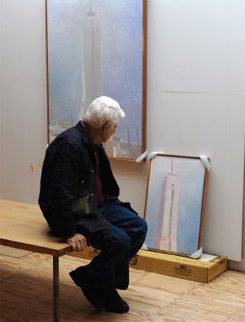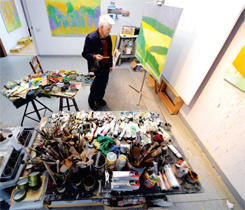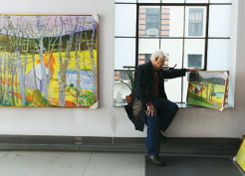Portrait of a Painter
Wolf Kahn, AB’50, talks concretely about abstract art.
By Terry Teachout
Photography by Dan Dry
Wolf Kahn’s studio is a magenta-and-yellow explosion. Brightly colored paintings are hanging on the walls, propped up in corners, piled high on the floors. It’s the last thing you’d expect to find on the top floor of an industrial building on a nondescript Manhattan side street. But artists who make their homes in New York City have to work somewhere, and more often than not their studios are cluttered oases of color that seem far removed the unsuspecting neighborhoods in which they’re located. The connection between Kahn’s bold, joyous art and the drab place where it’s made can only be seen by peering out a window and craning your neck to view the very top of the Empire State Building, which figures in several of his recent paintings. “Look!” he says, smiling puckishly. “There’s my model!”
Not that Kahn spends much time looking out of his studio windows. He works from memory, not life, and his subject matter normally runs more to New England barns than New York skyscrapers. In his paintings the American landscape is rendered in high-key colors that recall the luminous palette of Pierre Bonnard, whose influence Kahn happily acknowledges. Nor is there anything literal about his landscapes. One of the best-known pupils of Hans Hofmann, the Abstract Expressionist master who was as admired a teacher as he was a painter, Kahn passes his memories of the visible world through the transforming prism of abstraction. Some critics dismiss his style as pretty to a fault, but Kahn’s admirers side with the distinguished artist-critic Fairfield Porter, who praised him as “more French than Expressionist, with qualities few painters today seem to understand as well as he does.” The result is a deeply personal style in which abstraction and representation are so closely intertwined that they can’t be teased apart.
Many painters have little to say that can’t be said with a brush. The soft-spoken Kahn is both a blunt, funny raconteur and a talented writer. Wolf Kahn’s America: An Artist’s Travels, the 2003 volume in which he describes the places that inspired a hundred of his paintings and pastels, is in my view one of the best books ever written by an American artist. You can’t spend more than a minute or two talking to Kahn without being struck by his unpretentious yet unmistakable air of intellectual cultivation. In addition to studying at the Hans Hofmann School of Fine Arts, Kahn attended the College, where he picked up his bachelor’s degree in 1950 after eight intensive months of study. “It was one of the best years of my life,” he says. “And one of the most profitable. An artist profits from a liberal education. You learn critical thinking—not to get swept away by the marketplace. And you learn how to write. Nowadays an artist has to be his own promoter, his own spokesman, and you have to use nontechnical language in order to make art sound as interesting as baseball. Otherwise you won’t get anywhere.”
To chat with Kahn in his studio is the purest of pleasures and the easiest of jobs. All you have to do is prompt him with an occasional question, then sit back and enjoy the answers, taking care not to be distracted by the paintings everywhere you look. (That’s the hard part.) I visited him there last February, and this is some of what he said:
On the anxiety of influence. To drive toward “being yourself ” is ridiculous. It’s not an issue for me. I’ve never been afraid to be influenced. I’m still being influenced. Everything I like, I want to swallow up and disgorge it again. How could I make a secret of having been influenced by Bonnard? It’s clearly visible in the paintings—the paintings give the game away. And it doesn’t matter. To deal with categories, what’s going on in the art world, what the critics say, I think that’s wrong. When I paint, all I think about is one brush stroke after another. That’s what you have to think about.
On self-confidence. I’m 81 years old. If you’re not sure of yourself at that age, when are you going to be sure of yourself?
On music. I love it—I listen to a lot of it—but I don’t play it. Mostly classical music, though I grew up with bebop, and I can tell the difference between something that’s terrific and something else that’s just routine. I once took Charlie Parker home from the Five Spot when he was…well, out of it. My father was a conductor in Germany, but he wasn’t particularly interested in having me follow in his footsteps, and in any case my musical education was interrupted permanently by Hitler. At the point when people would normally start their music lessons, I became a refugee. I went to England in 1939, and from there to America. Now I’ve become sort of the court painter to the chamber-music establishment, partly because I have a summer house in West Brattleboro, Vermont, where the Marlboro Festival is located. Peter Serkin, Manny [Emanuel] Ax, Michael Tree of the Guarneri String Quartet, they all own paintings of mine. Jaime Laredo has practically a houseful of them! Up in Vermont, they understand that there’s such a thing as culture—not just agriculture.
On Hans Hofmann. The most important thing I learned from Hofmann was the dignity and importance of being an artist—that you were the carrier of higher values.
On the University of Chicago. I went to the Hofmann School after World War II, and I found it discouraging. For the first time in my life, I was in the company of my peers and my betters, guys who’d gone through the war. I wasn’t used to dealing with people who knew more about life and art than I did. I became quite depressed and lost my confidence, so I decided after a couple of years of it that I’d better do something else. The last thing that I’d done well was be a student, so I used up my G.I. Bill benefits to go to Chicago. I was going to become an aesthetician—I was going to bring Kant up to date. Of course I didn’t do that, I went back to painting, but a lot of the things I learned in my classes, I still use. I took an honors course from Kenneth Burke. We studied three works: Conrad’s Victory, The Portrait of a Lady, and Julius Caesar. He taught me to write more succinctly and elegantly, and he was extraordinarily clear in the classroom, though I never could understand anything that he wrote. He always made everything more difficult on paper. A Grammar of Motives? A Rhetoric of Motives? I don’t even know what the titles mean!
Back then the whole school was divided into logical positivists and neo-Platonists, and they hardly spoke to each other. I was a neo-Platonist and still am. I think that the idea of a sense of beauty is inherent in each individual, though it varies from individual to individual. A feeling that something is right and something else not right. A kind of relative absolutism, you might say.
On finishing a painting. A painting is done when it no longer gives you a royal pain in the ass.
On the painter’s life. I consider myself one of the fortunate people of the world. I make a decent living. I love this studio. I spend ten hours a day here, seven days a week—I really am a workaholic. People ask me where I go for a vacation, and I say, “My whole life’s a vacation.”




